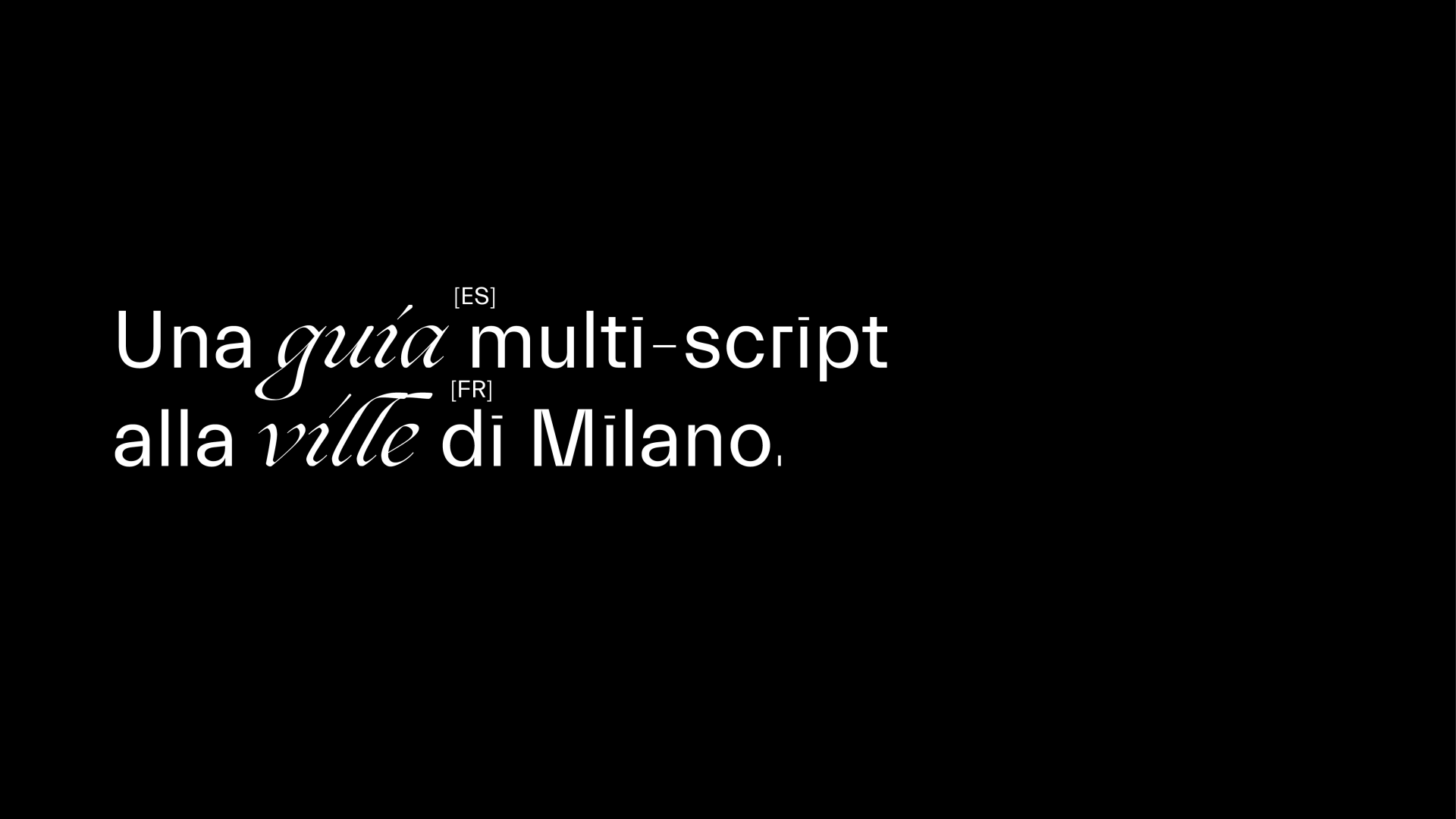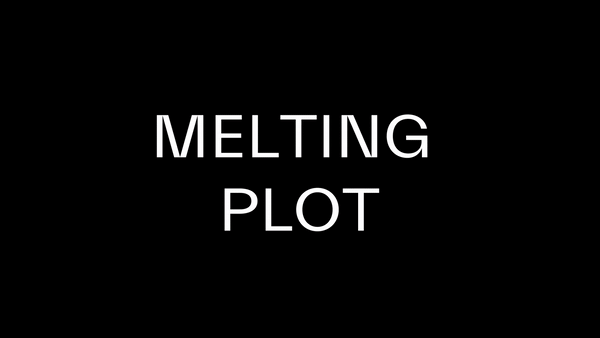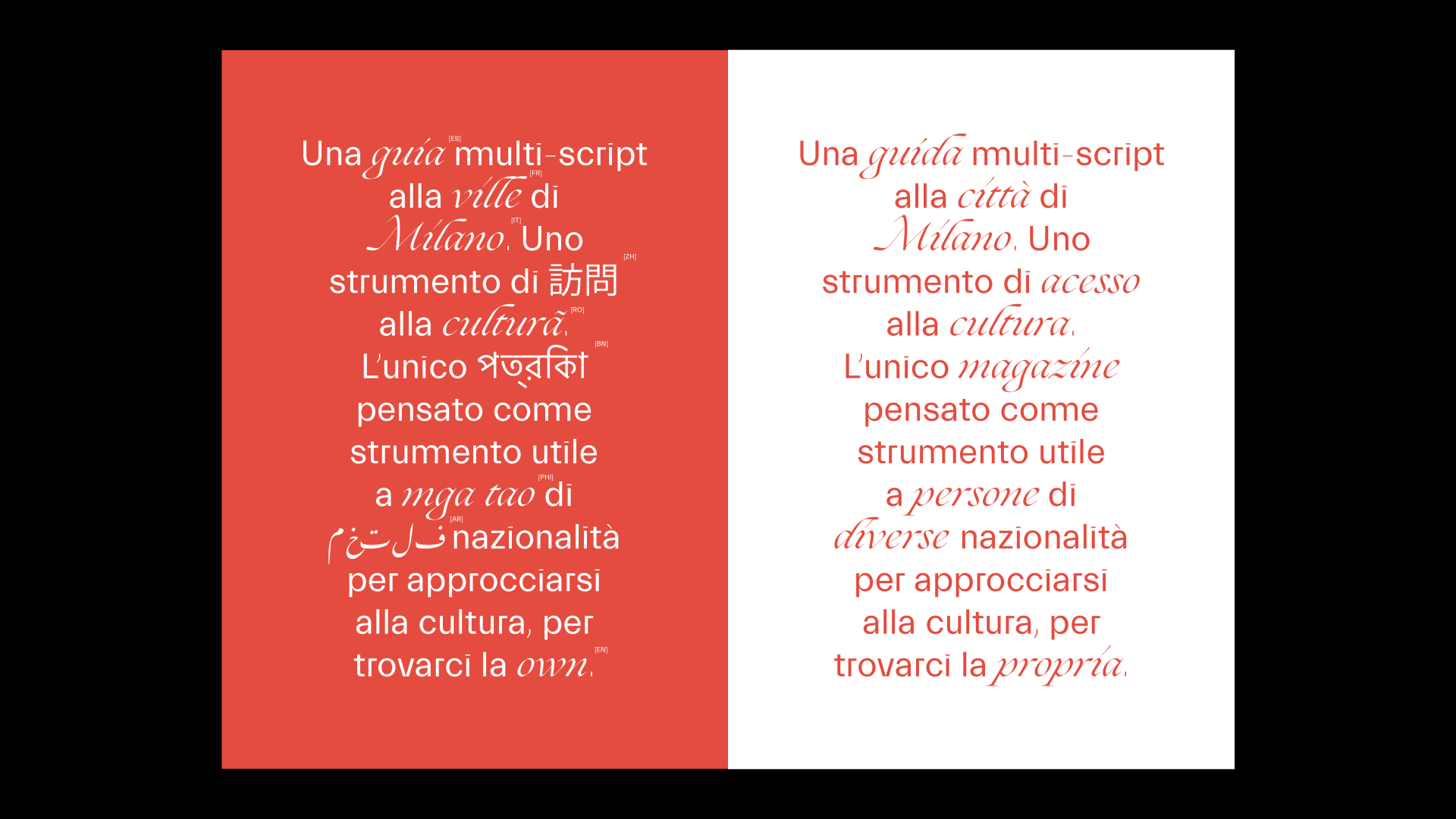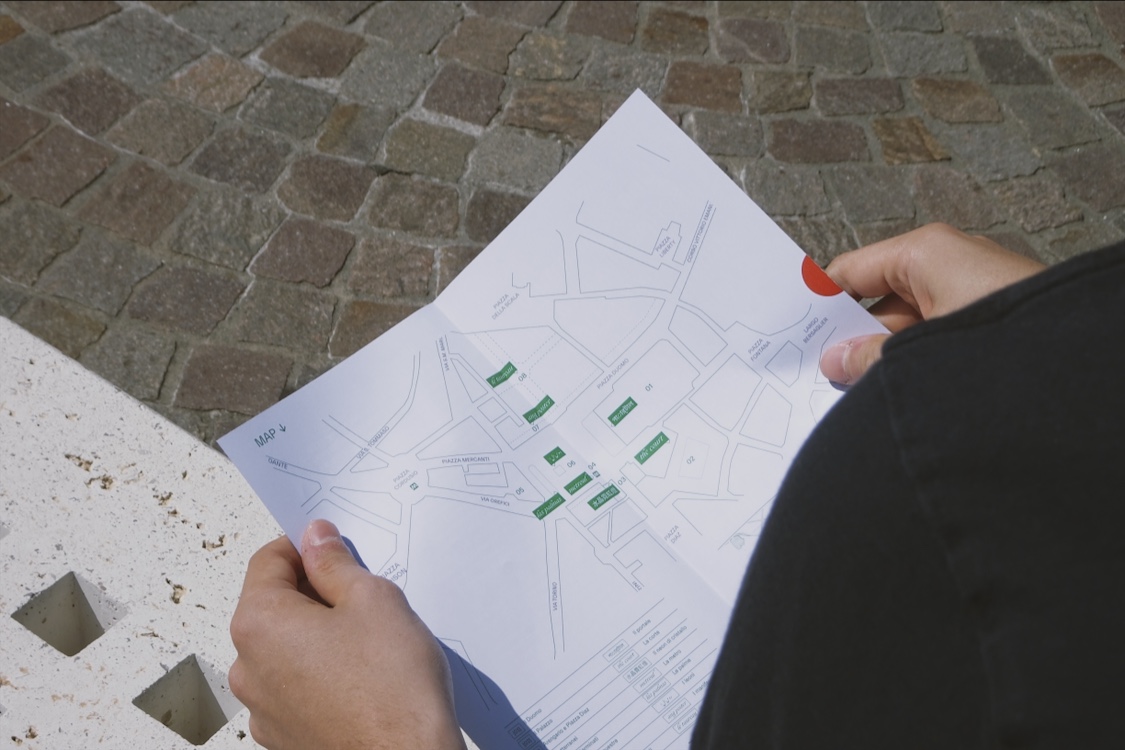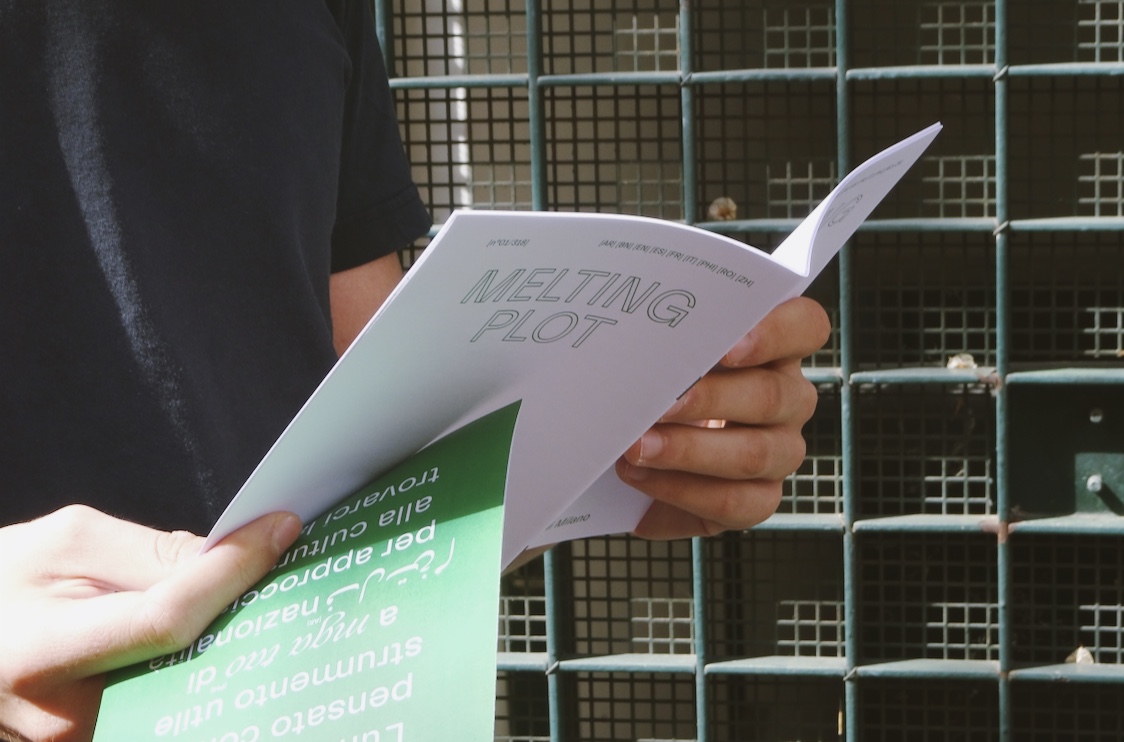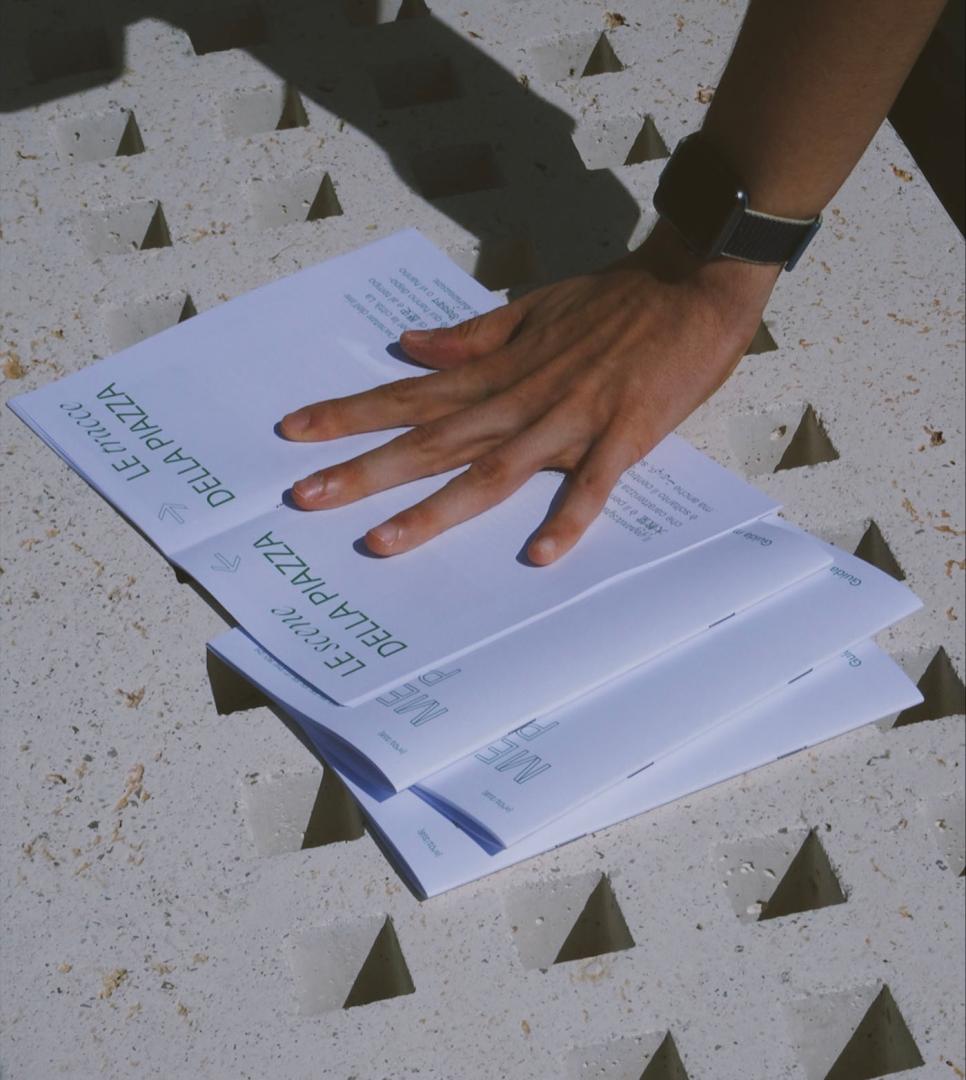Melting plot: design for mediation
Basic information
Project Title
Full project title
Category
Project Description
"Melting plot" is a multi-script city guide: a communication format and translation system for cultural mediation, fostering integration between cultural and linguistic alterities cohabiting our society.
Communication design plays a pivotal role in mediation between different cultures belonging to the same mixed society, starting from Milan cultural heritage as a case study. It helps access a city's plural identity scripts. It pursues engagement and a sense of belonging.
Geographical Scope
Project Region
Urban or rural issues
Physical or other transformations
EU Programme or fund
Which funds
Description of the project
Summary
MA Communication Design thesis, Politecnico di Milano, "Melting plot". A multi-script guide to the city of Milan. A magazine designed as a valuable tool for people of different nationalities to approach cultural heritage in diversity. "Melting plot" expresses the idea of integration and multi-ethnic encounter, together with a reference to the polyphony of signs and narratives that distinguish the city. Melting refers to the concept of a mixture, the cultural and the linguistic encounter within the text; plot, on the other hand, suggests narration and storytelling.
Method and translating steps:
1) The identification of scripts. A first necessary and preliminary step in the study of the communicative mechanism was the identification of the linguistic registers to be considered.
2) Linguistic integration. A fundamental requirement of the translation format is its use not only to guarantee linguistic access but also to transmit a social message of integration and coexistence. Unlike a simple translation tool, the chosen mechanism places the different writing systems on the same level, keeping Italian as "common ground". The code-mixing technique provides the insertion of individual terms in a different language or writing system.
3)Dynamic translation. The digital let the translation be dynamic and customizable. Starting from a text in code-mixing, it is possible to gradually modify some of its terms, aimed at grasping the general meaning of the text, or alternatively to prefer an integral translation, which does not replace the original text.
The project:
- The paper magazine: a free press for immediate use in the physical environment; it is a bridge between the place and the digital guide; finally, it helps to create storytelling through the "stages" of the different spots in the city, and potentially creates a bond with the user.
- The digital support introduces the dynamic translation of the text and amplified the content with multimedia elements.
Key objectives for sustainability
Sustainability in the UN Agenda 2030 is considered as a social matter, as highlighted in Goal 11: "Make cities inclusive, safe, resilient and sustainable." Facing our contemporary society's challenges, like social inequalities and discrimination, a sustainable communication design approach should also be considered in terms of accessibility for urban regeneration and community empowerment thanks to the cultural heritage's potential. «In a context where social inequalities are high and generalized discontent keeps growing, the participation in arts and cultural activities can play an important role in the achievement of broader social policy goals, such as promoting active citizenship and countering social exclusion. Cultural participation contributes to raising cognitive, creative and relational capabilities that empower people and make them feel part of a community.» (Wilson 2016)
Therefore accessibility means breaking down all those barriers that do not let users have equal experience and equal access: we are talking about tangible or intangible obstacles, which can be physical, sensory-perceptual, cognitive, behavioral, economic, technological, and above all cultural.
Even more, according to Richard Sandell, Professor at the University of Leicester, three fundamental practices contribute to determining the degree of accessibility of a cultural place: access, which focuses on ethnic minorities as potential publics; participation that concerns all the strategies implemented to make the cultural space more inclusive; and finally representation, which concerns the lack of pictures of certain groups or cultures in the heritage.
The project then embraces the topic of sustainability focusing on how graphic design can be an active part of fostering accessibility for an equal and therefore socially sustainable urban environment.
Key objectives for aesthetics and quality
The project aesthetics makes the primary intent of integration visually explicit, collecting all nine languages on the "same page" all nine languages, with four different linguistic scripts included in the guide. This process of dynamic translations claims for specific attention on both visual and typographical traditions of each culture to make the text more affordable.
The analogic magazine works as a "manifesto" of the multi-script inclusion, showing a mixed text that a single individual cannot translate. Still, it powerfully expresses the metaphor of the encounter in the same place. From the analogic paper guide, the user can move to the website app and experience the site in an immersive way to replace the actual participation. Here, the multiscript text assumes a new meaning, standing for all the multicultural persons living the place in real life. The digital part leads to a more interactive reading, personalized by the user, but still visually maintains the text-integration visual metaphor.
The technique of code-mixing answers to the translation required by the multicultural audience; the necessity of at least a partial accessibility to the text for the majority of pleple, attracted by the words that they can immediatly understand; the intent of a graphic outcome unique and attractive, and above all visually metaphorical.
Key objectives for inclusion
The project focuses on multicultural mediation processes mainly from a linguistic and conceptual point of view. «Script is Language. Language is communication, and communication is the key to successful intercultural exchange. » (Ben Wittner).
The "Multi-script" concept considers the multiplicity of linguistic registers used in the city environment and the plurality of cultures and forms of expression. If, on the one hand, multilingualism becomes a need for access and understanding, on the other, it also assumes as a symbolic value for a more faithful representation and translation of plurality. Inherent in the project is the idea of a potential meeting and rapprochement between cultures, both functional and representative.
At the first level of interpretation, the use of different linguistic registers allows to break down those language barriers, which are a characterizing element of a plural society. Therefore it makes it possible to become more accessible to various people, who perhaps only partially share the Italian culture and have limited knowledge of the language.
The role of communication design is not only to communicate but also to convey messages and think of graphic artifacts that can impact and efficacy in society. Mediation approach cannot be resolved in simple inter-linguistic translation, but it needs to make explicit the encounter between pluralities to pursue integration and inclusiveness. To conclude, the project's intent is to achieve a broader inclusion and integration, considering a plural linguistic translation system. It also demands community participation in sharing their cultural knowledge to make it more accessible and let people perceive a stronger engagement and sense of belonging to the place where they live, but they may not feel the spirit.
Physical or other transformations
Innovative character
The project represents a communication format of multicultural inclusion for an accessible and sustainable society through an innovative visual solution for content organization. These three elements are combined to consider how cultural access can effectively be an urban and social regeneration tool in terms of multicultural integration.
The topic of sustainability is reframed in terms of cultural accessibility and social inclusivity, facing social inequalities and discrimination in the multicultural society. Therefore it refers to the process of inclusion and integration between the different entities cohabiting the urban environments. To do so, communication design for mediation considers both a possible strategy of reshaping content to make them more widely accessible and a visual and aesthetic format effectively able to translate and express the project intentions. This process aims to promote community engagement and reshape the quality standards of the city's cultural experience for each user.

